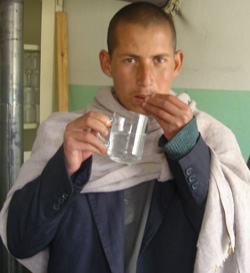You are here » Home » Telling Our Story
Success Story
Preventing and treating tuberculosis in Afghanistan
Bringing Hope to Tuberculosis Patients

| |
Photo: REACH
|
|
Wasil, a 17-year-old diagnosed with tuberculoses, takes his medication at a USAID-assisted health clinic.
Effective in 86 percent of tuberculosis cases treated in Afghanistan, the USAID-sponsored treatment regime requires patients to commit to daily treatment at a clinic for two months and weekly treatment for six months thereafter.
|
Seventeen-year-old Wasil is one of 76,000 Afghans with new, active cases of tuberculosis (TB) each year. Without treatment half of those infected will succumb to the disease.
As a child, Wasil watched his mother die of TB. When her all-too-familiar symptoms — persistent cough, loss of appetite, weight loss, and fever — became apparent, Wasil sought help from a USAID-sponsored health clinic. At the clinic, an examination confirmed a TB diagnosis, and Wasil began treatment known as DOTS - directly observed therapy, short course.
Globally recognized as the best way to cure TB and control its spread, DOTS is an eight month program in which health providers directly administer medications and closely monitor patient progress. Effective in 86 percent of cases in Afghanistan, DOTS requires patients to commit to daily treatment for two months, and twice weekly treatment for six months thereafter. Wasil was fortunate; many of his fellow Afghans neither recognize the symptoms of TB nor have access to health facilities with DOTS.
USAID is providing technical assistance to expand detection and treatment of TB in Afghanistan. The program supplies clinics with educational flip cards and charts with pictures that describe symptoms, explain transmission and prevention, and inform patients that TB is curable. In addition, health workers help patients comply with DOTS by visiting them twice weekly in their homes to administer medication. These home visits spare patients the daily trips to the clinic made during the first two months of the regimen, making it easier, especially for women with children, to receive treatment.
Since USAID launched its program, access to DOTS has expanded. In 13 of 34 provinces, the number of DOTS-capable health clinics has risen from 15 in early 2004 to 121 in January 2006. By 2006, over 6,000 community health workers had trained under the program — 53 percent of them were women.
Much work lies ahead in Afghanistan’s battle against TB, but important inroads have been made. Public knowledge about TB is growing, the detection rate and number of DOTS clinics are rising, and patients like Wasil are staying the course, completing DOTS, and claiming longer, healthier lives.
Print-friendly version of this page (421kb - PDF)
Click here for high-res photo
Back to Top ^ | 

